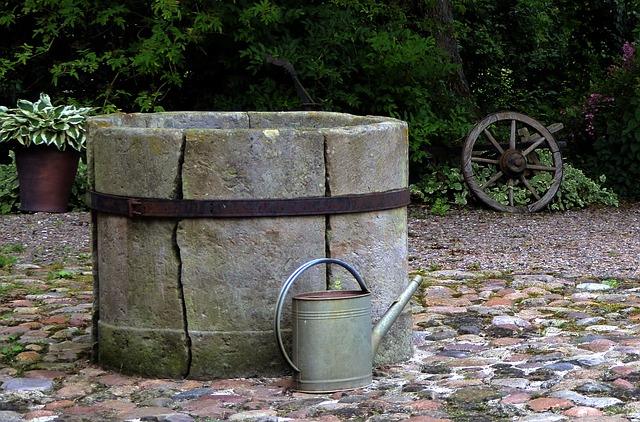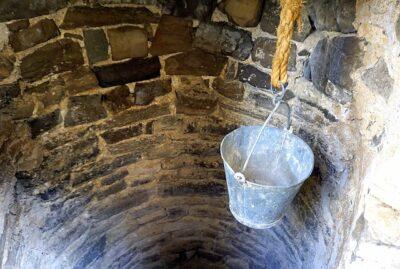Water is one of those commodities that many people take for granted. Like electricity or natural gas, a lot of us are accustomed simply to flipping a switch or turning a knob or lifting a handle, and there it is. It may be that we have not had occasion even to wonder about the manner in which it traveled from its source to our homes. It is provided by a municipal or for-profit entity, and all we have to do is pay the bill.
In most truly rural locations, people are on their own for water. Typically, that means having a private well. If you have never had to be responsible for water accession, the idea of doing so can be a little daunting.
If having a private well is new to you, following are a few basic facts about owning one that might be helpful to know before you take up homesteading or country life.
1. It is possible for a well to run dry. While there are different well-drilling technologies, different climates, and different demands for water, no well is completely infallible. When that happens, homesteaders are likely to be on their own. When piped-in water fails, the onus is upon the water company to rectify the problem. When a private well fails, it is the owner’s problem.
That said, it is uncommon for good quality wells to fail or run dry. Wells which are shallow, dug (as opposed to drilled), makeshift, poorly sited, or located in an arid climate are more likely to have problems than those which are deeper, professionally drilled, or in an area with a high underground water table and ample rainfall.
2. Well water is not tested unless the owner tests it. Again, in this age of having certain aspects taken care of for us by experts, it is easy to forget that rural living does not include all the same benefits. Out in the country, the only way we know what is in our water is to have it tested.
In my region, the process is simple and inexpensive. It amounts to picking up small plastic jars from a nearby commercial laboratory, following instructions for filling them at the kitchen faucet, and returning them to the lab. If you are unsure how to proceed where you live, ask your county cooperative extension, your municipal office, a state official or even a professional realtor.
3. Water can be contaminated by fertilizers, pesticides, herbicides or naturally occurring substances. Residue from a myriad of sources, from commercial crops to livestock to landfills to your own landscaping practices, can seep into groundwater. In addition to external contaminants, geology can play a large role in water quality. Toxins such as arsenic and radon are common in my region, and homeowners need to be diligent in determining levels of dangerous elements in their well water.
Get Free Backup Electricity — That Works Even During Blackouts!
Many toxins are treatable. Some are as easy as adding chlorine, and others require extensive mitigation equipment.
If you are purchasing a property with an existing well, be sure to test the water before you buy the property. If you are planning to build a well on property you already own, have the water evaluated as you proceed.
4. Additives are not present in well water unless the owner adds them. This can be both a benefit and a drawback to having your own private water source. You can control any chlorine or other chemical elements in your water, but you do not have the advantage of having what many consider to be beneficial additives. Some dental professionals say that children raised in impoverished rural areas have two strikes against them—not only the reduced access to dental care, but the lack of fluoride in drinking water. Other science suggests fluoride treatment is more of a risk than a benefit. The takeaway is simply this: Make sure you know what you are and are not getting in your water, and if there is something of value missing, be proactive about attaining it elsewhere.
5. The cost of creating a well depends greatly. Primarily, it rests upon the type of soil, the presence or not of ledge below the surface, and the type of well that is best for your geography. For example, a high water table — meaning that underground water stays close to the surface — and soft sandy soil can mean that a simple point well can serve nicely. These conditions are also more conducive to dug wells than are harder soils with a higher concentration of clay and ledge. For the latter, a well probably needs to be drilled with professional equipment, especially if the best reliable source of water lies deep below the surface.
6. Do not forget codes and regulations. Many areas have strict codes regarding the location and type of wells which can be created. You may or may not need a permit for your well. Check with your local authorities before you start to dig.
7. Well water travels from the well to your faucet by way of a pump. Homesteaders who are on the grid often use an electric well pump, which can be situated either inside the well itself or closer to the interior plumbing of the home. In-well pumps are more labor intensive and often more costly to install, while interior pumps are noisier. Interior pumps cost more to run, as well, since the act of pulling water takes more energy than pushing it.
Crazy Gadget Makes Every Window A Cell Phone Solar Charger
If you have an electric pump, you will lose the ability to draw water when the power goes out. If this is your situation, it is important to keep ample water on hand for possible outages. It is a good idea to keep a supply of clean water in sterile glass jars for human consumption, and larger amounts of water in plastic barrels for flushing.
Having a hand pump on your well, as either a primary pump or for use in emergencies—is an even better idea. If you can afford to add one to your existing pump setup, you are likely to someday be glad you did.
As an aside, not all rural water supplies rely upon a well at all. Some homesteaders and off-gridders successfully use nature’s power to provide them with water, utilizing such resources as rainwater, natural springs or other water bodies and harnessing gravity to move the water to where they need it. If you can get reliable water year-round without a well, go for it!
Among the many positive aspects of having your own well is the fact that you are not in danger of suffering from someone else’s bad decisions. You can be in charge of making sure there is no lead in your pipes and no contaminants in your groundwater. On the other hand, when something does go awry, it is your responsibility to correct it. But until something happens, there are no monthly bills for water, no unwanted chemicals, and often a far better taste. Once you become accustomed to the unique rewards and responsibilities of having your own well water, you will likely agree that living with a private well is worth what it takes to do it right.
What would you add to our list? Share your well water tips in the section below:
 Off The Grid News Better Ideas For Off The Grid Living
Off The Grid News Better Ideas For Off The Grid Living





